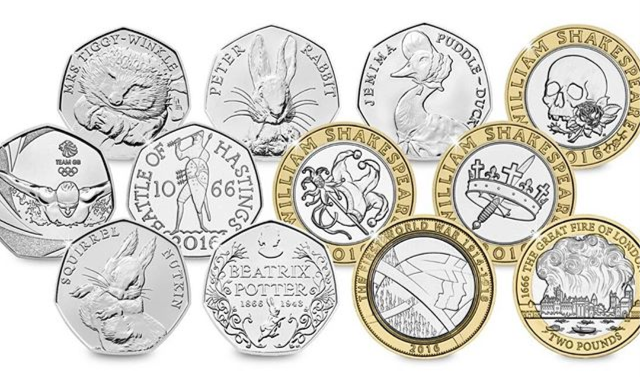Posts Tagged ‘£1’
2016 mintage figures just released!
The Royal Mint have just released the mintage figures for the 2016 dated circulation coins.

Mintage figures have been released for the 2016 coins.
These are the new figures:
WW1 Army £2 – 9,550,000
Shakespeare Comedies £2 – 4,335,000
Shakespeare Histories £2 – 4,615,000
Shakespeare Tragedies £2 – 5,695,000
Great Fire of London £2 – 5,135,000
Britannia £2 – 2,925,000
Peter Rabbit 50p – 9,600,000
Beatrix Potter 50p – 6,900,000
Jemima Puddle-Duck 50p – 2,100,000
Mrs Tiggy-Winkle 50p – 8,800,000
Squirrel Nutkin 50p – 5,000,000
Team GB 50p – 6,400,000
Battle of Hastings 50p – 6,700,000
We’ll have a closer look at these figures and come back with a full analysis on Monday with updated graphs so stay tuned!
£1 mis-strikes make headline news
Since it’s introduction in 2017, the 12 sided £1 coin has made front page news time and again from members of the public spotting mis-struck £1 coins in their change.

However, it’s important to be aware that these headlines can vastly overstate the scale of the problem.
In 2017, 1.5 billion £1 coins were struck – that’s 30 coins a second – so it’s inevitable that some variances have occurred during the striking process, affecting a small number of coins.
But remember, mis-strikes and variances are not the same as genuine errors. Here are some of the £1 mis-strikes that have been reported…
The ‘Melt in the middle’ £1
This £1 coin, found in Birmingham by Sarah O’Donoghue, was thought to have melted in the middle, causing the Bi-Metallic parts of the coin to bleed into one another. However, this isn’t actually the case and is in fact likely to be because of a ‘bad’ or misaligned blank being used leading to this particular mis-strike.
This particular mis-struck £1 coin, and a few others that have been found recently, are undoubtedly numismatic curiosities. Whilst they make for interesting collection, it’s likely that these coins will fetch little more than face value if put up for sale. However, the minting process is never completely exempt from human error, so it is worth checking your change carefully.
“It is very unlikely that there is a serious problem with the new £1 coins. With the large amount of coins that were struck ready for the launch in 2017, it is inevitable that there will be some variances among a small number of the £1 coins. With the coins causing excitement in the press and more people than ever checking their change, these mis-strikes are cropping up more than usual.” – Ian Glen (Change Checker Managing Director)
The ‘polo’ pound
There have also been reports of 12-sided £1 coins missing the middle section of the coin – BUT, collectors should beware...

As a word of warning to those wanting to get hold of one of these coins, don’t be fooled into spending more than you need to.
It’s relatively easy to prize the two parts of metal apart by freezing the coin and using a chisel to knock the middle section out.
Ultimately these mis-strikes are unlikely to make anyone rich, but they are undoubtedly very interesting and would make an exciting addition to any coin collection.
Find out about all the the differences that have been spotted in the 12 sided £1 here.
As we mentioned earlier, mis-strikes are not the same as genuine errors. BUT there are some errors to be aware of, such as the dual dated £1.
Find out more about your coins
If you’re interested in coin collecting, our Change Checker web app is completely free to use!

Rumours of fake £1 coins denied by Royal Mint
The Royal Mint has denied claims that there are already counterfeit 12-Sided £1 coins in circulation after a charity worker pointed out discrepancies between two coins.
Roy Wright, a charity worker from Surrey, was shocked when he noticed a few subtle differences between the two £1 coins, leading him to believe he had found the ‘first fake £1 coin’.
Impossible to counterfeit
Despite the new £1 coins being designed to be ‘impossible to counterfeit’, Mr Wright suggested that coin he had was heavier, had no hologram and the Queen’s head was positioned more to the left. Not only that, the edges were more rounded and there was no detail on the head of the thistle.
A genuine coin with a production fault…
Whilst the story has caused some excitement in the press and The Royal Mint has not yet been able to examine the offending coin, they are confident it is not a fake, but instead a genuine coin with a production fault.
Despite tight quality controls being in place, The Royal Mint has said that variances are likely to occur during the striking process in a small numbers of coins. Whilst such mis-strikes are relatively unusual and can be numismatically interesting, they are not the same as genuine errors.
Rumours of a genuine error in circulation
Unconfirmed rumours have also been circulating about some new £1 coins featuring two dates. There are reports of some coins having 2016 on the obverse and 2017 engraved in the micro lettering of the reverse.
Although, we are yet to see an example, if this is true, it would have to be the result of mis-matched 2016 and 2017 dies being used during production – a genuine error or “mule”.
Of course, it was the use of an incorrect die that resulted in the most famous modern “error” – the “undated 20p coin“, now regarded by many as the Holy Grail of change collecting. You can read more about the story of the undated 20p here.
If you’ve #foundapound in your change, have you spotted anything strange about it?



